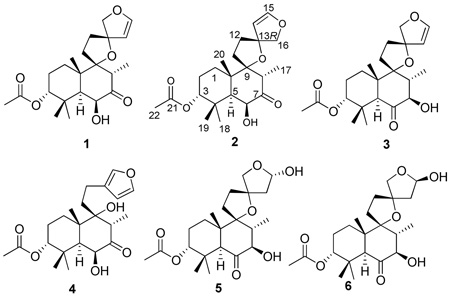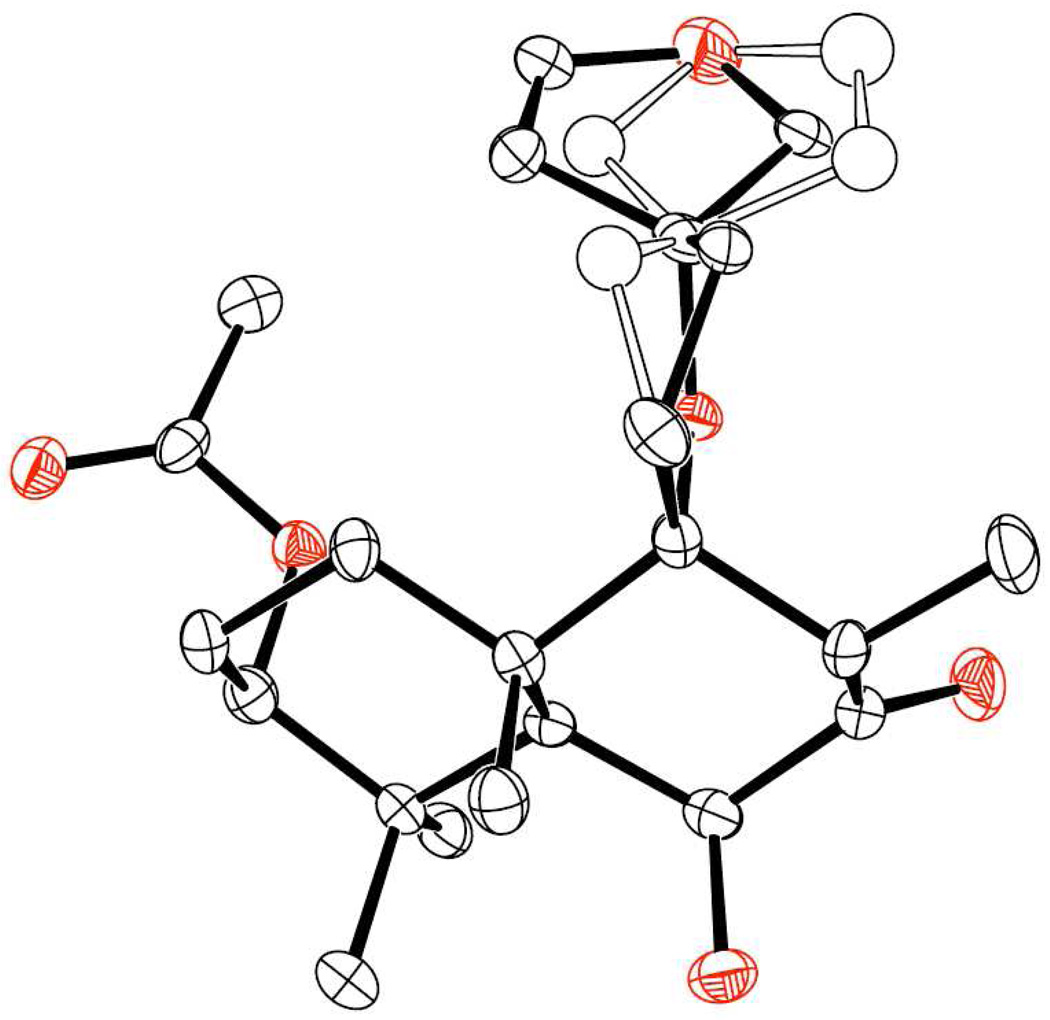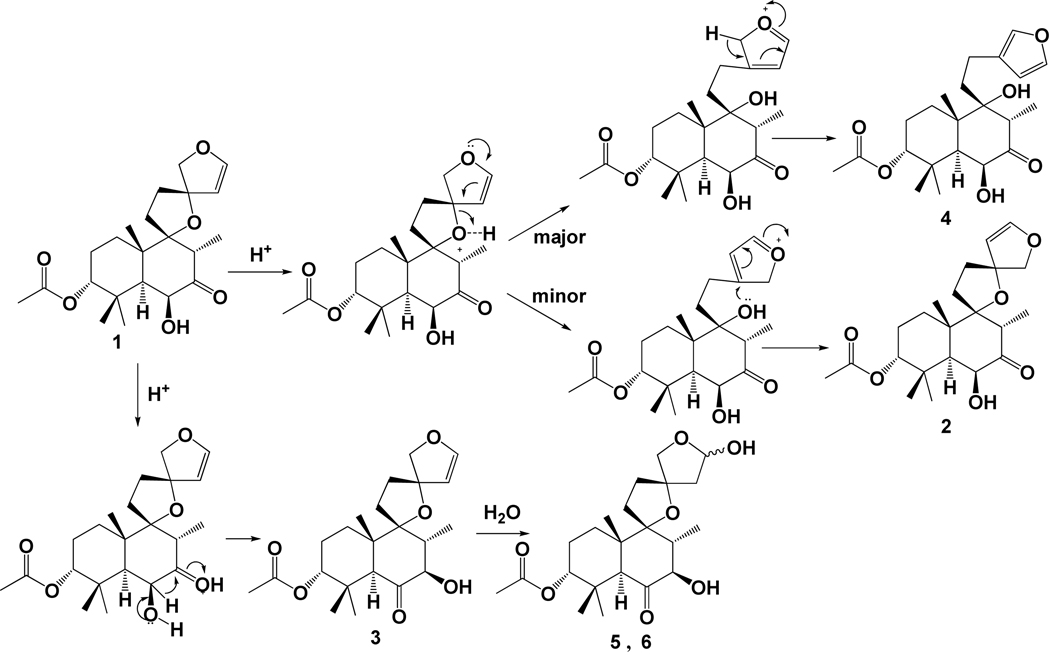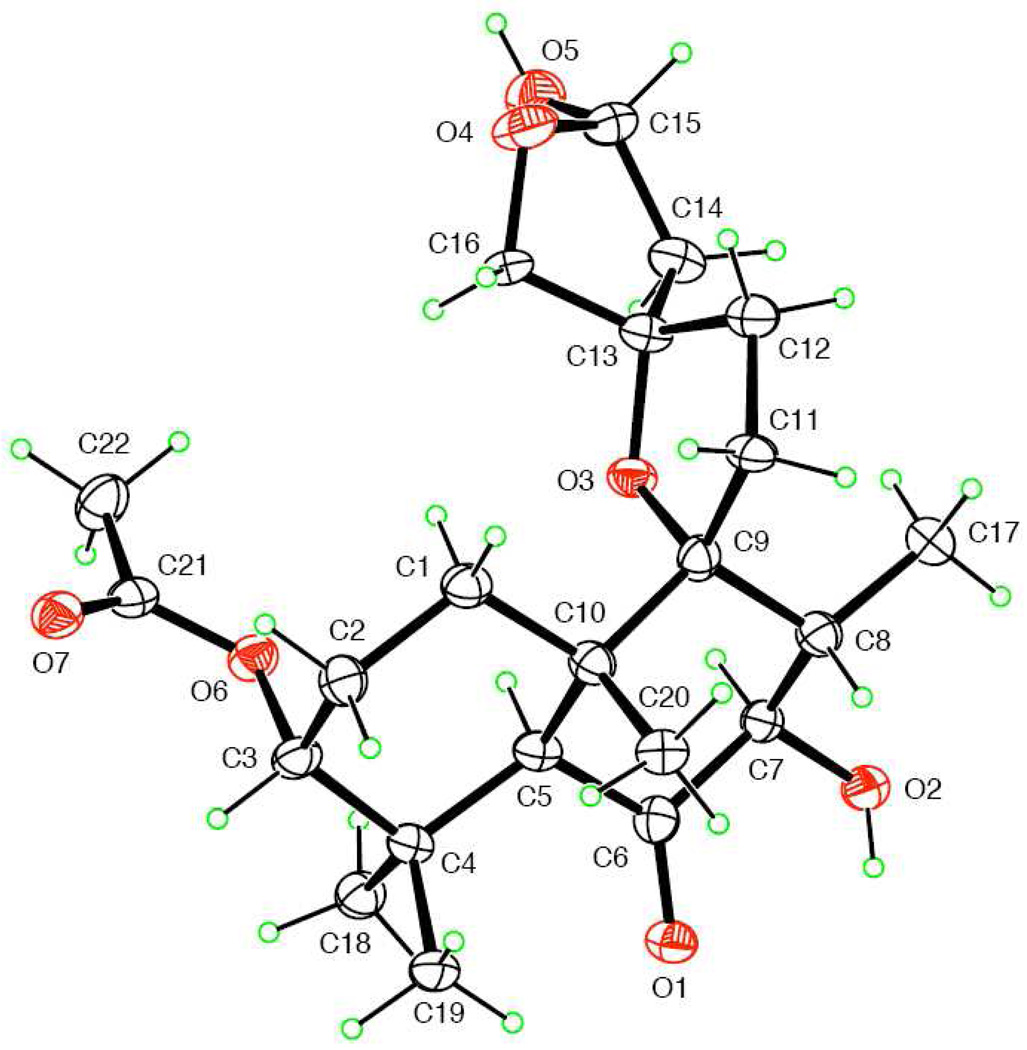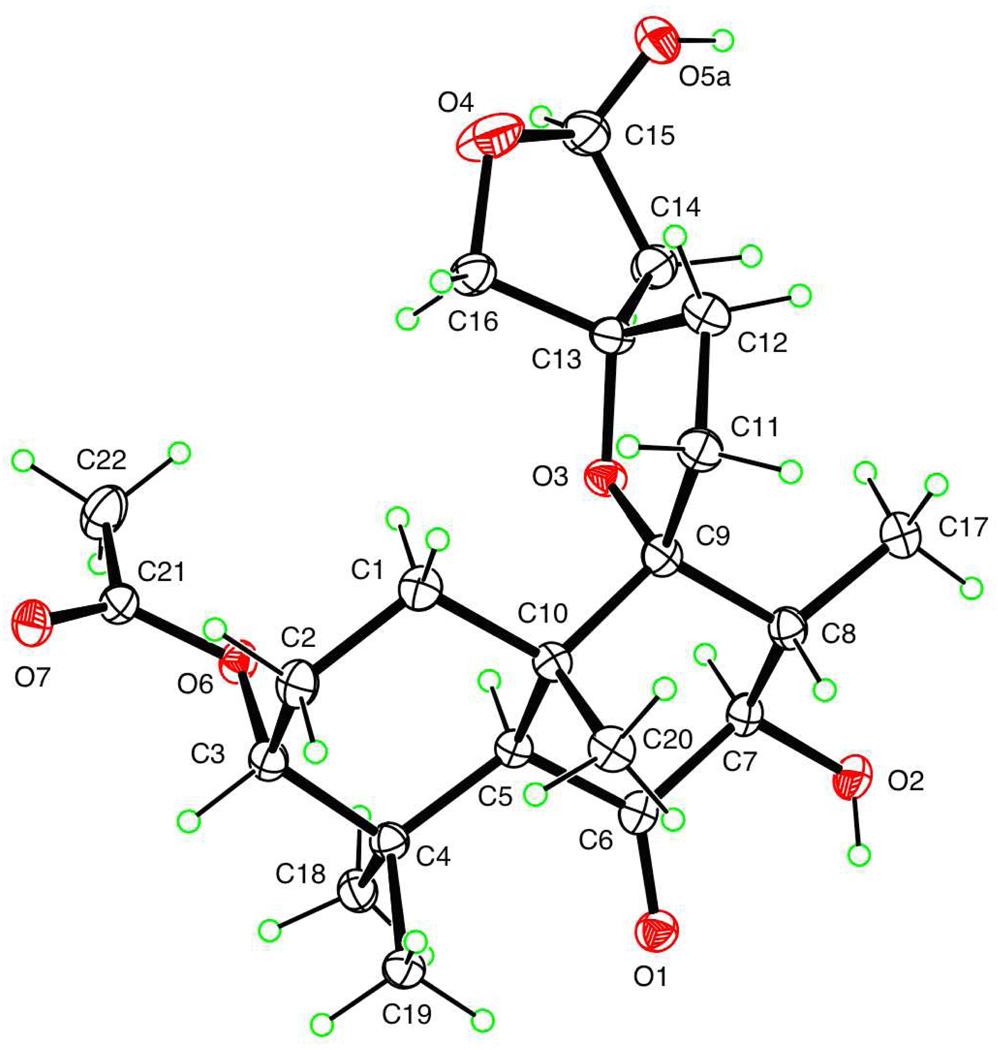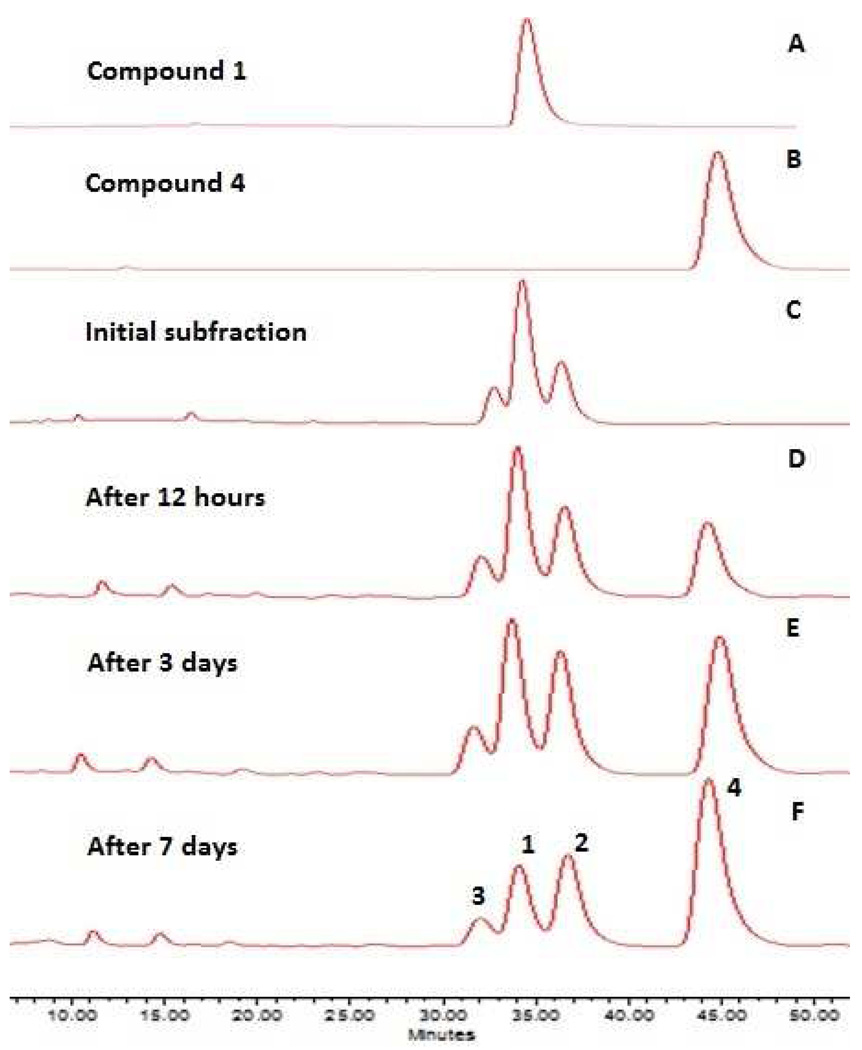Abstract
Six new labdane diterpenoids, preleosibirone A (1), 13-epi-preleosibirone A (2), isopreleosibirone A (3), leosibirone A (4), leosibirone B (5), and 15-epi-leosibirone B (6), were isolated from the leaves of Leonurus sibiricus. The absolute configurations of 1, 2, 5, and 6 were established by X-ray crystallographic analyses, and leosibirone A (4) was shown to be an artifact of the isolation process.
Leonurus sibiricus L. (Lamiaceae) is a widely distributed medicinal plant in southern Siberia, China, Korea, Japan, Vietnam, and elsewhere in Southeast Asia. It is commonly known as “motherwort” in Asian countries. It has been introduced to Mexico, and named as “marihuanilla” (Spanish “little marijuana”). The plant is used traditionally for various ailments, such as menstrual irregularities, high blood pressure, blood stasis, heart disorders, and dysentery.1–6 Leaves harvested from the flowering plant are dried and smoked as a marijuana substitute. The effects are described as mildly narcotic or cannabis-like.7 Previous phytochemical investigations resulted in the isolation of alkaloids, flavonoids, iridoids, and phenylpropanoid glycosides.8–12 In addition, there are several reports of labdane diterpenoids from L. sibiricus.8, 13–16 Herein, we report the isolation and structure elucidation of six new labdane diterpenoids (1–6) from this species.
Results and Discussion
The n-hexane extract of the aerial parts of L. sibiricus was passed through an MCI gel (DIAION® HP20SS) column and eluted with MeOH to remove chlorophyll and then separated by semi-preparative HPLC to give compounds 1–6.
Preleosibirone A (1) was obtained as a white powder, [α]25D −23.3° and its molecular formula was determined as C22H32O6 by HRESIMS (m/z 415.2086 [M+Na]+). The 1H and 13C NMR, and HSQC spectroscopic data confirmed the presence of 22 carbons. Other features strongly suggested the presence of a spirobisdihydrofuran labdane, close to preleosibirin17, precalyone18 or isopreleoheterin.19 Thus, the characteristic signals of spiro carbons C-9 (δC 96.6) and C-13 (δC 93.7), and the diagnostic C-16 oxymethylene (δC 80.6; δH 4.27 and 4.00, d, J = 10.0 Hz), and the H14-H15 enol ether function (AB system, δH 6.40 and 5.02, d, J = 2.4 Hz) were observed. HMBC correlations of Me-18 and Me-19 established C-3 and those of H-3 and CH3COO with CH3COO pointed out the presence of an acetoxy group at C-3 and the A-ring structure as in precalyone.18 The correlation of Me-17 with a C=O fixed the carbonyl position at C-7 and other correlations permitted and confirmed the assignment of ring B hydroxy and carbonyl functionalities as in isopreleoheterin.19 The relative configuration of the stereogenic centers of 1 was deduced as follows. The H-5 and H-6 coupling constant (J = 3.2 Hz) placed the two protons cis to each other in an α-axial, α-equatorial orientation, leaving the hydroxy group as β-axial. The unusually low-field signal (δH 3.39) of H-8 for an α-carbonyl proton could only be explained if this hydrogen is perpendicular to the vicinal carbonyl group above the molecular plane, leaving the C-17 methyl as α-equatorial, which agreed with the coupling constant of J = 6.8 Hz, as axial methyl groups exhibit a larger coupling constant (8.0 Hz). An X-ray crystallography study of disordered co-crystals of 1 and 2 (Figure 1) revealed the acetoxy group to be connected to C-3, and H-5, H-6, and Me-17 as α-oriented, with Me-20 and H-5 in β-axial and α-axial orientations, respectively. The NOESY correlation between H-14 and Me-17 confirmed the (13S)-configuration. These data conclusively proved the new structure of 1 as 3α-acetoxy-9α,13S; 15,16-diepoxy-6β-hydroxylabd-14-en-7-one, which has been named preleosibirone A.
Figure 1.
ORTEP drawing of co-crystal of 1 and 2. The atoms represented as outlines only are the minor (23.9%) component 1. H atoms are not shown.
13-epi-Preleosibirone A (2) was obtained as a white solid, [α]25D −19.0° and its molecular formula determined as C22H32O6 by HRESIMS (m/z 415.2086 [M+Na]+). The 1H and 13C NMR data of 2 were similar to those of 1 (Tables 1 and 2). Similar to the arguments advanced for compound 1, the NOESY correlation between H-16 and Me-17 confirmed the (13R)-configuration. An X-ray crystallographic analysis of co-crystals of 1 and 2 (Figure 1) similarly revealed the C-3 acetoxy group as α-oriented, with H-5, H-6, and Me-17 also α-oriented. Thus, the structure of 2 was determined as 3α-acetoxy-9α,13R; 15,16-diepoxy-6β-hydroxylabd-14-en-7-one, and, as an epimer of 1, thus named 13-epi-preleosibirone A.
Table 1.
1H NMR Data of Compounds 1 – 6 (δ in ppm, J in Hz, 400 MHz)
| position | 1a | 2a | 3a | 4a | 5/6b |
|---|---|---|---|---|---|
| 1 | 1.63, m | 1.49, m | 1.80, m | 1.98, m | 1.82, m |
| 2 | 1.90, m | 1.88, m | 1.70, m | 2.05, m | 1.70, m |
| 3 | 4.46, m | 4.12, m | 4.51, br s | 4.52, br s | 4.35, br s |
| 5 | 2.10, overlap | 2.10, m | 3.30, s | 2.20, br | 3.03, s |
| 6 | 4.07, d (3.2) | 4.05, br. s | 4.17, br s | ||
| 7 | 3.80, d (4.0) | 3.84, br s | |||
| 8 | 3.39, q (6.8) | 3.54, q (6.8) | 1.90, m | 3.55, q (6.8) | 1.85, m |
| 11 | 2.02, m | 2.10, m | 2.10, m | 2.10, m | 2.09, m |
| 12 | 2.22, m | 2.20, m | 2.20, m | 2.56, m | 2.10, m |
| 14 | 5.02, d (2.4) | 5.22, d (2.4) | 5.31, d (2.4) | 6.38, s | 1.70, m |
| 2.37, m | |||||
| 15 | 6.40, d (2.4) | 6.48, d (2.4) | 6.59, d (2.4) | 7.44, s | 5.40, d (4.4) /5.27, s |
| 16 | 4.00, d (10.0) | 4.04, d (10.4) | 4.23, d (10.0) | 7.37, s | 3.56, d (7.6) |
| 4.27, d (10.0) | 4.28, d (10.4) | 4.58, d (10.0) | 3.80, d (7.6) | ||
| 17 | 0.98, d (6.8) | 0.98, d (6.8) | 1.22, d (6.8) | 1.11, d (6.8) | 1.05, d, (6.8) |
| 18 | 0.89, s | 0.93, s | 0.95, s | 0.96, s | 0.84, s |
| 19 | 1.31, s | 1.37, s | 1.35, s | 1.42, s | 1.25, s |
| 20 | 1.45, s | 1.49, s | 0.91, s | 1.55, s | 0.78, s |
| 22 | 2.00, s | 1.95, s | 2.16, s | 2.05, s | 2.00, s/2.01, s |
Measured in acetone-d6.
Measured in DMSO-d6.
Table 2.
13C NMR Data of Compounds 1 – 6 (δ in ppm, 100 MHz)
| 1a | 2a | 3a | 4a | 5/6b | |
|---|---|---|---|---|---|
| carbon | δC, mult. | δC, mult. | δC, mult. | δC, mult. | δC, mult. |
| 1 | 28.7, CH2 | 27.5, CH2 | 28.4, CH2 | 35.2, CH2 | 29.0/29.1, CH2 |
| 2 | 22.5, CH2 | 22.5, CH2 | 21.8, CH2 | 22.6, CH2 | 25.1/25.5, CH2 |
| 3 | 78.5, CH | 78.7, CH | 78.0, CH | 78.4, CH | 77.8/78.0, CH |
| 4 | 37.6, C | 37.8, C | 35.4, C | 37.7, C | 35.6/35.7, C |
| 5 | 43.4, CH | 44.3, CH | 51.2, CH | 43.4, CH | 51.5/51.9, CH |
| 6 | 75.0, CH | 75.4, CH | 211.06, C | 75.3, CH | 211.5/211.5, C |
| 7 | 207.6, C | 208.0, C | 77.5, CH | 208.9, C | 77.7/77.8, CH |
| 8 | 44.7, CH | 45.2, CH | 46.1, CH | 45.2, CH | 46.0/46.5, CH |
| 9 | 96.6, C | 96.6, C | 94.2, C | 81.5, C | 91.8/92.2, C |
| 10 | 42.8, C | 42.5, C | 47.7, C | 43.5, C | 47.4/47.5, C |
| 11 | 27.6, CH2 | 27.5, CH2 | 28.4, CH2 | 27.2, CH2 | 29.0/29.1, CH2 |
| 12 | 37.9, CH2 | 36.9, CH2 | 37.5, CH2 | 22.6, CH2 | 38.4/39.1, CH2 |
| 13 | 93.7, C | 93.3, C | 92.2, C | 125.5, C | 90.6/91.1, C |
| 14 | 107.2, CH | 107.2, CH | 107.5, CH | 110.8, CH | 46.0/46.5, CH2 |
| 15 | 148.1, CH | 147.7, CH | 148.2, CH | 142.8, CH | 97.5/98.0, CH |
| 16 | 80.6, CH2 | 80.3, CH | 80.6, CH | 138.6, CH | 74.5/76.8, CH |
| 17 | 8.6, CH3 | 8.7, CH3 | 12.9, CH3 | 7.8, CH3 | 13.4/13.6, CH3 |
| 18 | 28.7, CH3 | 28.1, CH3 | 26.1, CH3 | 27.4, CH3 | 26.9/26.9, CH3 |
| 19 | 23.7, CH3 | 23.7, CH3 | 21.4, CH3 | 23.9, CH3 | 22.1/22.2, CH3 |
| 20 | 19.5, CH3 | 19.0, CH3 | 19.3, CH3 | 18.6, CH3 | 19.7/19.9, CH3 |
| 21 | 169.4, C | 171.8, C | 169.3, C | 169.6, C | 170.0/170.0, C |
| 22 | 20.2, CH3 | 20.2, CH3 | 20.3, CH3 | 20.2, CH3 | 21.3/21.4, CH3 |
Measured in acetone-d6.
Measured in DMSO-d6.
Isopreleosibirone A (3) was obtained as white solid, [α]25D −9.0° and its molecular formula determined as C22H32O6 by HRESIMS (m/z 415.2089 [M+Na]+). Most of the 1H and 13C NMR signals indicated a spirobisdihydrofuran and ring A moieties identical to 1. The different arrangement of ring B substituents was based on correlations of H-5 (singlet) and H-7 with the C-6 carbonyl, and Me-17 with C-7 and C-9, as well as H-5 with C-9, allowed the assignment of substituents in ring B. The relative configurations of C-5 and C-7 were determined from their NOESY data. Correlation of H-7 with H-5 indicated their α-orientation. As for compounds 1 and 2, the (13S)-configuration of 3 was deduced from the NOESY correlation between H-14 and Me-17. Compared with preleoheterin,20 and 13-epi-preleoheterin,19 compound 3 shared most of the spectroscopic observations. Thus, the structure of 3 was assigned as 3α-acetoxy-9α,13S;15,16-diepoxy-7β-hydroxylabd-14-en-6-one, an isomer of 1, and named isopreleosibirone A. It is possible that 3 is an artifact arising from preleosibirone A (1) by an α-ketol rearrangement leading to interchange of the hydroxy and carbonyl groups.
Leosibirone A (4) was obtained as a white solid, [α]25D −20.0°, and its molecular formula determined as C22H32O6 by HRESIMS (m/z 415.2072 [M+Na]+). The 1H NMR spectrum (Table 1) indicated the presence of a furanolabdane system. Thus, it exhibited the typical proton resonances of a β-substituted furan moiety at δH 7.44, 7.37, and 6.38, three methyl singlets at δH 1.55, 1.42, and 0.96, and one methyl doublet at δH 1.11 (J = 6.8 Hz), coupled with a vicinal proton (3.55, q, J = 6.8 Hz). The HMBC correlations of Me-18 and Me-19 with C-3, and H-3 with the acetoxy carbonyl group indicated the location of the acetoxy group at C-3 rather than at C-6. Correlations of H-5, H-6, H-8, and Me-17 with the C-7 carbonyl confirmed the structure of ring B. Compound 1 was not stable in solution and was readily converted into 4 under very mild acidic conditions, even in 90% MeOH/water overnight at room temperature. The mechanism of this conversion is presented in Scheme 1. This type of conversion has been reported before, as exemplified by precalyone being converted to calyone,18 preleosibirin being converted to leosibirin with Amberlite IR-120(H+),13 preleoheterin being converted to leoheterin with aq. 0.5% HCl,20 and pregaleopsin being quantitatively converted to galeopsin during storage at +4 °C for 2–3 months.21 Thus, the structure of 4 was established as 3α-acetoxy-15,16-epoxy-6β,9α-dihydroxylabda-13(16),14-dien-7-one, and named leosibirone A.
Scheme 1.
Possible transformation of 1 to 2 – 6.
Leosibirone B (5) and 15-epi-leosibirone B (6), were isolated as a mixture of two isomers with the molecular formula, C22H34O7, as determined by HRESIMS ([M+Na]+ 433.2197, [M+NH4]+ 428.2629). Their 13C NMR data showed the presence of a ketone carbonyl and an acetoxy group but no further sp2-hybridized carbon atoms that indicated a tetracyclic structure of 5/6. Closer scrutiny of the 1H and 13C NMR data revealed the structure of 5/6 to be quite similar to those of leopersin C and 15-epi-leopersin C, 22 except for the presence of an acetoxy group (δH 2,00/2.01, s, 3H each; δC 21.3/21.4 and 170.0 × 2) in 5/6. In the HMBC spectrum, correlations between H-3 (δH 4.35)/-OCOCH3 (δH 2.01) and –OCOCH3 (δC 170.0), and between H-3 and C-5/Me-18/Me-19 suggested that the acetoxy group resides at C-3. The relative configurations of C-5, C-7, C-8, C-9, C-10, and C-13 in 5/6 were assigned on the basis of NOESY correlations. The observation of cross peaks in the NOESY spectrum between H-5/H-7, H-5/Me-18, H-7/Me-17, and Me-17/H-5 indicated that they are all α-cofacial, while the interactions between H-8/Me-20, H2-11/Me-20, and Me-19/Me-20 revealed these to be on the β face. Additional NOE interactions between Me-17 and H-16 indicated the 13S configuration.
The absolute configuration of 5 was established by a low-temperature single crystal X-ray analysis (Figure 2). Interestingly, compound 5 was selected manually from the mixture of 5 and 6 as transparent crystals. However, 6, a white solid, was not suitable for X-ray analysis. A crystallization of the 5/6 mixture from MeCN yielded excellent co-crystals isomorphous with the structure of 5. The structure of the minor (23.9%) component 6 is shown in Figure 3. In solution, compounds 5 and 6 were inseparable and underwent spontaneous α,β-anomerization similar to the process of mutarotation of the hemiacetal functionality in carbohydrates. Thus, compounds 5/6 were identified as 3α-acetoxy-7β,15α-dihydroxy-9α,13α;15,16-diepoxylabd-6-one and 3α-acetoxy-7β,15β-dihydroxy-9α,13α;15,16-diepoxylabd-6-one, and named leosibirone B and 15-epi-leosibirone B, respectively. It is possible that compounds 5 & 6 are produced from water addition to the enol ether functionality of compound 3 (Scheme 1).
Figure 2.
ORTEP drawing of compound 5.
Figure 3.
ORTEP drawing of the minor component 6, in the disordered co-crystal of 5 and 6.
Genkwanin (apigenin 7-O-methyl ether) was obtained as light-yellow precipitate by addition of MeOH to the n-hexane extract and identified on the basis of NMR data. It is very common in Leonurus and is considered as a chemotaxonomic marker of this genus.14
Pre-furanoid and furanoid diterpenes are abundant in many species of the family Lamiaceae. However, it is inevitable that the rupture of the C-9α and C-13 epoxy bridge or solvent addition to the C-14-C-15 double bond during the isolation process, would produce furanoid diterpenes or tetrahydrofurans. To establish whether the isolated compounds are true natural products or artifacts, HPLC was used to analyze the stability of the compounds in the extract. A series of chromatograms indicated that compound 1 was dominant among the three compounds in the initial fraction. Compound 4 was absent in the original fraction. After 12 hrs in 90% MeOH/H2O, 4 was present in a significant concentration, with the increase in concentration continuing until the 7th day when it represented the main component in the mixture (Figure 4). These results indicate that compound 2 is more stable under the prevailing conditions than 1. This may be explained by the fact that the conversion of 1 into 4 requires a trans-elimination of H and OR, which is not permitted in 2, and, during the process of conversion, 2 (a minor product) was formed (Scheme 1). Thus, this experiment and the observations made have demonstrated that some of the furanoid-diterpenoids may have been produced during extraction and isolation.
Figure 4.
HPLC profiles of the extract and stability (condition 65% MeOH-water).
Experimental Section
General Experimental Procedures
Optical rotations were acquired with a Rudolph Research Analytical Autopol V automatic polarimeter. IR spectra were recorded on a Bruker Tensor 27 spectrophotometer. NMR spectra were recorded on a Bruker DRX NMR spectrometer operating at 400 MHz for 1H and 100 MHz for 13C with a 3 mm direct carbon probe. The mass detector was time of flight (model G1969A) equipped with an electrospray ionization interface and was controlled by Aligent software (Aligent Mass Hunter Work Station, A.02.01). HPLC was carried out using a Delta Prep 4000 (Waters Corporation, Milford, MA) instrument equipped with a dual wavelength detector Model 2487 adjusted at 210 and 254 nm. The HPLC column was Phenomenex Luna C8 (250 × 10.00 mm, 5 µm).
Plant Material
The leaves of L. sibiricus were purchased from IAmShaman Shop (P.O. Box 12618 Chicago, IL 60612) in June, 2010, and authenticated by C. L. Burandt Jr. A voucher specimen (Code: hkwu-LS-20100806) was deposited at the Department of Pharmacognosy, School of Pharmacy, University of Mississippi.
Extraction and Isolation
The dried and powdered leaves of L. sibiricus (20 g) were extracted with n-hexane (2 × 300 mL) by sonication at room temperature. The solvent was evaporated under reduced pressure at 40 °C to yield 0.5 g (2.5%) of a viscous syrup. Addition of MeOH (10 mL) gave a yellowish precipitate identified as genkwanin. After filtering, the filtrate was passed through a short column packed with DIAION® HP20SS resin. This was eluted with MeOH to give 163.5 mg of a light yellow semisolid after concentration. The semisolid was purified further by semi-preparative HPLC (65% aq. MeOH, flow rate: 2 mL/min) to afford compounds 1 – 6: 1 (tR = 38.1 min, 1.3 mg), 2 (tR = 39.6 min, 1.4 mg), 3 (tR = 35.7 min, 0.8 mg), 4 (tR = 47.5 min, 1.5 mg), 5/6 (tR = 18.3 min, 1.0 mg).
Preleosibirone A (1)
white powder; −23.3° (c 0.09, MeOH); IR (KBr) νmax 3434, 2929, 2877, 1713, 1640, 1616, 1457, 1367, 1250 cm−1; 1H and 13C NMR data, Tables 1 and 2; HRESIMS m/z 415.2086 [M+Na]+ (calcd for C22H32O6Na 415.2096).
13-epi-Preleosibirone A (2)
white powder; −19.0° (c 0.11, MeOH); IR (KBr) νmax 2942, 2881, 1717, 1612, 1461, 1376, 1258, 1140, 1079 cm−1; 1H and 13C NMR data, Tables 1 and 2; HRESIMS m/z 415.2086 [M+Na]+ (calcd for C22H32O6Na 415.2096).
Isopreleosibirone A (3)
white powder; −9.0° (c 0.20, MeOH); IR (KBr) νmax 3454, 2978, 2942, 2893, 1730, 1607, 1469, 1372, 1245, 1144 cm−1; 1H and 13C NMR data, Tables 1 and 2; HRESIMS m/z 415.2089 [M+Na]+ (calcd for C22H32O6Na 415.2096).
Leosibirone A (4)
white powder; −20.0° (c 0.10, MeOH); IR (KBr) νmax 3454, 2967, 2932, 2882, 1716, 1466, 1381, 1264, 1159 cm−1; 1H and 13C NMR data, Tables 1 and 2; HRESIMS m/z 415.2072 [M+Na]+ (calcd for C22H32O6Na 415.2096).
Leosibirone B (5) and 15-epi-Leosibirone B (6)
white solid; −10.0° (c 0.18, MeOH); IR (KBr) νmax 2944, 2877, 1731, 1710, 1448, 1375, 1244, 1022 cm−1; 1H and 13C NMR data, Tables 1 and 2; HRESIMS m/z 433.2197 [M+Na]+ (calcd for C22H34O7Na 433.2202).
X-ray Crystallography
The crystal structures of a disordered co-crystal of 1 and 2, of 5, and of a disordered co-crystal of 5 and 6 were determined, using data collected at T = 90 K with CuKα radiation (λ = 1.54178 Å) on a Bruker APEX-II CCD diffractometer, equipped with an Oxford Cryostream cooler. Structures were solved using the program SHELXS-9723 and refined anisotropically by full-matrix least squares on F2 using SHELXL-97.23 For each disordered co-crystal, the populations of the two components were refined and constrained to sum to unity. The absolute configurations were determined by refinement of the Flack24 parameter based on resonant scattering of the light atoms and computation of the Hooft parameter,25 in all cases yielding a probability of 1.000 that the reported configuration is correct. Crystal data: 1–2 co-crystal, C22H32O6, Mr = 392.48, monoclinic space group P21, a = 12.1972(10), b = 8.9304(5), c = 18.0154(14) Å, β = 90.176(5)°, V = 1962.3(2) Å3, Z = 4, Dx = 1.328 Mg m−3, θmax = 68.1°, R = 0.028 for 6870 data and 553 refined parameters. There are two independent molecules in the asymmetric unit, both of which exhibit disorder, with partial occupancy of the two epimers. Refinement of populations led to 11.1(7)% 1; 88.9(7)% 2 for one molecule and 0.368(6)% 1; 63.2(6)% 2 for the other. Thus, the overall population of the two epimers in the crystal is 23.9(5)% 1 and 76.1(5)% 2. The Flack parameter is 0.02(10) and the Hooft parameter is 0.04(4) for 3106 Bijvoet pairs. 5, C22H34O7, Mr = 410.49, orthorhombic space group P212121, a = 11.373(3), b = 11.703(2), c = 15.508(3) Å, V = 2064.1(8) Å3, Z = 4, Dx = 1.321 Mg m−3, θmax = 58.3°, R = 0.052 for 2873 data and 270 refined parameters, Hooft parameter 0.0(2) for 1210 Bijvoet pairs. 5–6 co-crystal, C22H34O7, Mr = 410.49, orthorhombic space group P212121, a = 11.3687(9), b = 11.7108(9), c = 15.5053(11) Å, V = 2064.3(3) Å3, Z = 4, Dx = 1.321 Mg m−3, θmax = 68.3°, R = 0.031 for 3706 data and 281 refined parameters. Populations refined to 78.1(4)% 5 and 21.9(4)% 6. The Flack parameter is 0.09(15) and the Hooft parameter is 0.08(4) for 1543 Bijvoet pairs. Crystallographic data for the compounds 1 & 2 (CCDC 795187), 5 (CCDC 795188), 5 & 6 (CCDC 796447) have been deposited with the Cambridge Crystallographic Data Centre. It is available free of charge upon request via the Internet at http://www.ccdc.cam.ac.uk/.
Supplementary Material
Acknowledgment
The project was supported by a grant from National Institutes of Health (R03DA023491). We are grateful to Dr. B. Avula for assistance with the HRESIMS.
Footnotes
Supporting Information Available: 1D and 2D NMR spectra of compounds 1–6, This material is available free of charge via the Internet at http://pubs.acs.org.
References
- 1.Bensky D, Clavey S, Stöger E. Chinese Herbal Medicine: Materia Medica. 3rd ed. Seattle: Eastland Press; 2004. p. 614. [Google Scholar]
- 2.Bae KW. The Medicinal Plants of Korea. Seoul: Kyo-Hak Publishing; 2000. p. 437. [Google Scholar]
- 3.Honychurch PN. Caribbean Wild Plants & Their Uses. London and Basingstoke, U.K.: Macmillan Education Ltd.; 1986. p. 52. [Google Scholar]
- 4.Carrington S. Wild Plants of Barbados. London and Basingstoke, U.K.: Macmillan Press Ltd.; 1993. p. 90. [Google Scholar]
- 5.Carrington S. Wild Plants of the Eastern Caribbean. London and Basingstoke, U.K.: Macmillan Education Ltd.; 1998. p. 85. [Google Scholar]
- 6.Hocking GM. A Dictionary of Natural Products. Medford, NJ: Plexus Publishing Inc.; 1997. p. 437. [Google Scholar]
- 7.Ratsch C. The Encyclopedia of Psychoactive Plants. South Paris, ME: Park Street Press; 2005. pp. 320–321. [Google Scholar]
- 8.Tasdemir D, Çalis I, Sticher O. Phytochemistry. 1998;49:137–143. doi: 10.1016/s0031-9422(97)00982-5. [DOI] [PubMed] [Google Scholar]
- 9.Calis I, Ersoz T, Tasdemir D, Ruedi P. Phytochemistry. 1992;31:357–359. doi: 10.1016/0031-9422(91)83078-y. [DOI] [PubMed] [Google Scholar]
- 10.Yeung HW, Kong YC, Lay WP, Cheng KF. Planta Med. 1977;31:51–56. doi: 10.1055/s-0028-1097489. [DOI] [PubMed] [Google Scholar]
- 11.Chen ZS, Chen CX, Kwan CY. Biomed. Res. (Aligrah, India) 2000;11:209–212. [Google Scholar]
- 12.Pan SM, Ding HY, Chang WL, Ling HC. Chin. Pharm. J. 2006;58:35–40. [Google Scholar]
- 13.Savona G, Piozzi F, Bruno M, Rodriguez B. Phytochemistry. 1982;21:2699–2701. [Google Scholar]
- 14.Boalino DM, McLean S, Reynolds WF, Tinto WF. J. Nat. Prod. 2004;67:714–717. doi: 10.1021/np030480i. [DOI] [PubMed] [Google Scholar]
- 15.Satoh M, Satoh Y, Isobe K, Fujimoto Y. Chem. Pharm. Bull. 2003;51:341–352. doi: 10.1248/cpb.51.341. [DOI] [PubMed] [Google Scholar]
- 16.Moon HT, Jin Q, Shin JE, Choi EJ, Han HK, Kim YS, Woo ER. J. Nat. Prod. 2010;73:123–126. doi: 10.1021/np900471x. [DOI] [PubMed] [Google Scholar]
- 17.Bruno M, Savona G, Pascual C, Rodriguez B. Phytochemistry. 1986;25:538–539. [Google Scholar]
- 18.Prakash O, Bhakuni DS, Kapil RS, Subba Rao GSR, Ravindranath B. J. Chem. Soc., Perkin Trans. I. 1979:1305–1308. [Google Scholar]
- 19.Romero-González RR, Ávila-Núñez JL, Aubert L, Alonso-Amelot ME. Phytochemistry. 2006;67:965–970. doi: 10.1016/j.phytochem.2006.03.015. [DOI] [PubMed] [Google Scholar]
- 20.Hon P-M, Wang E-S, Lam SKM, Choy Y-M, Lee C-M, Wong HNC. Phytochemistry. 1993;33:639–641. [Google Scholar]
- 21.Tasdemir D, Wright AD, Sticher O, Calis I, Linden A. J. Nat. Prod. 1995;58:1543–1554. [Google Scholar]
- 22.Tasdemir D, Wright AD, Sticher O, Calis I. J. Nat. Prod. 1996;59:131–134. [Google Scholar]
- 23.Sheldrick GM. Acta Cryst. 2008;A64:112–122. [Google Scholar]
- 24.Flack HD. Acta Cryst. 1983;A39:876–881. [Google Scholar]
- 25.Hooft RWW, Straver LH, Spek AL. J. Appl. Cryst. 2008;41:96–103. doi: 10.1107/S0021889807059870. [DOI] [PMC free article] [PubMed] [Google Scholar]
Associated Data
This section collects any data citations, data availability statements, or supplementary materials included in this article.



